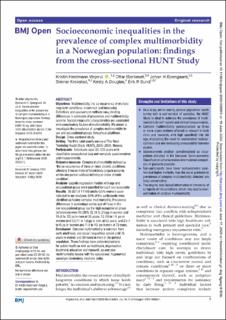| dc.contributor.author | Vinjerui, Kristin Hestmann | |
| dc.contributor.author | Bjerkeset, Ottar | |
| dc.contributor.author | Bjorngaard, Johan H. | |
| dc.contributor.author | Krokstad, Steinar | |
| dc.contributor.author | Douglas, Kirsty A. | |
| dc.contributor.author | Sund, Erik R. | |
| dc.date.accessioned | 2020-08-24T08:13:01Z | |
| dc.date.available | 2020-08-24T08:13:01Z | |
| dc.date.created | 2020-06-29T22:42:25Z | |
| dc.date.issued | 2020 | |
| dc.identifier.citation | BMJ Open. 2020, 10 (6), | en_US |
| dc.identifier.issn | 2044-6055 | |
| dc.identifier.uri | https://hdl.handle.net/11250/2673495 | |
| dc.description.abstract | Objectives Multimorbidity, the co-occurrence of multiple long-term conditions, is common and increasing. Definitions and assessment methods vary, yielding differences in estimates of prevalence and multimorbidity severity. Sociodemographic characteristics are associated with complicating factors of multimorbidity. We aimed to investigate the prevalence of complex multimorbidity by sex and occupational groups throughout adulthood.
Design Cross-sectional study.
Setting The third total county survey of The Nord-Trøndelag Health Study (HUNT), 2006–2008, Norway.
Participants Individuals aged 25–100 years with classifiable occupational data and complete questionnaires and measurements.
Outcome measure Complex multimorbidity defined as ‘the co-occurrence of three or more chronic conditions affecting three or more different body (organ) systems within one person without defining an index chronic condition’.
Analysis Logistic regression models with age and occupational group were specified for each sex separately.
Results 38 027 of 41 193 adults (55% women) were included in our analyses. 54% of the participants were identified as having complex multimorbidity. Prevalence differences in percentage points (pp) of those in the low occupational group (vs the high occupational group (reference)) were 19 (95% CI, 16 to 21) pp in women and 10 (8 to 13) pp in men at 30 years; 12 (10 to 14) pp in women and 13 (11 to 15) pp in men at 55 years; and 2 (−1 to 4) pp in women and 7 (4 to 10) pp in men at 75 years.
Conclusion Complex multimorbidity is common from early adulthood, and social inequalities persist until 75 years in women and 90 years in men in the general population. These findings have policy implications for public health as well as healthcare, organisation, treatment, education and research, as complex multimorbidity breaks with the specialised, fragmented paradigm dominating medicine today. | en_US |
| dc.language.iso | eng | en_US |
| dc.publisher | BMJ Publishing Group | en_US |
| dc.rights | Navngivelse-Ikkekommersiell 4.0 Internasjonal | * |
| dc.rights.uri | http://creativecommons.org/licenses/by-nc/4.0/deed.no | * |
| dc.title | Socioeconomic inequalities in the prevalence of complex multimorbidity in a Norwegian population: findings from the cross-sectional HUNT Study | en_US |
| dc.type | Peer reviewed | en_US |
| dc.type | Journal article | en_US |
| dc.description.version | publishedVersion | en_US |
| dc.source.volume | 10 | en_US |
| dc.source.journal | BMJ Open | en_US |
| dc.source.issue | 6 | en_US |
| dc.identifier.doi | 10.1136/bmjopen-2020-036851 | |
| dc.identifier.cristin | 1817692 | |
| dc.description.localcode | This is an open access article distributed in accordance with the Creative Commons Attribution Non Commercial (CC BY-NC 4.0) license, which permits others to distribute, remix, adapt, build upon this work non-commercially, and license their derivative works on different terms, provided the original work is properly cited, appropriate credit is given, any changes made indicated, and the use is non-commercial. See: http://creativecommons.org/licenses/by-nc/4.0/. | en_US |
| cristin.ispublished | true | |
| cristin.fulltext | original | |
| cristin.qualitycode | 1 | |

